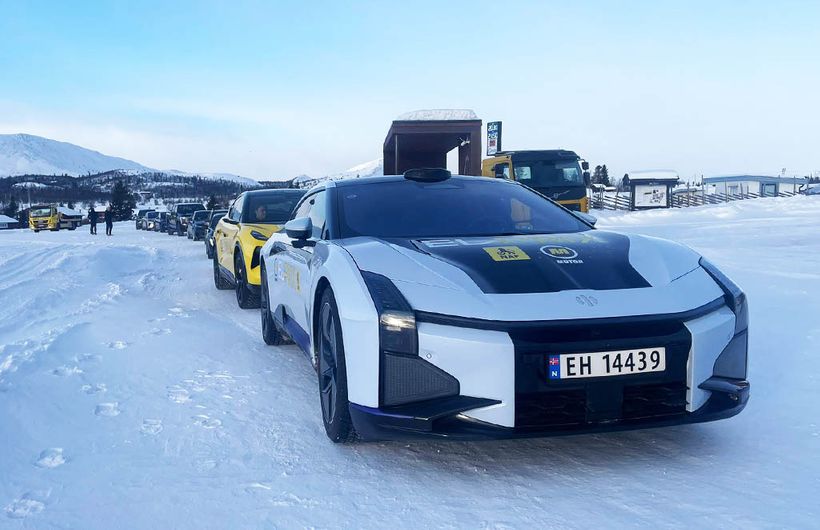The world’s biggest real-world cold weather test has revealed which cars lose the most range in low temperatures. The independent research was carried out by Norwegian Automobile Federation (NAF) during its bi-annual El Prix, and put 23 of the world’s biggest selling electric vehicles through a series of gruelling sub-zero range tests.
The results show that after four years of domination, Tesla has been deposed as the king of the cold. Topping the charts for the least amount of range lost (when comparing real world figure to the WLTP figure) was Chinese newcomer HiPhi. The brand’s Z model recorded a real world cold weather range of 324 miles, just 21 miles less than the official WLTP figure.
In second was another recently launched model, the BMW i5 eDrive40, which drove for 275 miles in sub-zero temperatures before stopping - just 39 miles less than the WLTP figure. Rounding out the top three were the all-new Kia EV9 and Lotus Eletre which both posted a 40 mile drop between the tested real-world figure and the official WLTP figure.
The event saw all 23 models driven in identical conditions across a pre-planned route in Norway. During the tests, the temperatures ranged between -2° and -10° and were driven by a range of drivers to ensure a level playing field for all the cars. As part of the test, all cars were charged to 100% capacity and driven until they ran out of charge. Depleted cars were then collected and returned the test centre. The tests were overseen by the FIA
Among the drivers taking part in the test was electrifying.com's own Nicola Hume. “The test was really well organised to ensure that all the data was spot-on. Each car had two people on board, the climate control was set to 21 degrees in every car and we had to stick to all the speed limits.”
While HiPhi, BMW and Kia locked out the top positions, there was bad news for brands that recorded the biggest drops in range. Volkswagen’s new ID.7 recorded the biggest cold weather range drop, recording a real world range of 257 miles against a WLTP figure of 378 miles - a 121 mile difference. The Toyota bZ4X meanwhile recorded a real-world test figure that fell 91 miles short of its official WLTP figure. The Japanese SUV managed just 195 miles on a full charge against an official WLTP figure of 286 miles.
Surprisingly, Tesla’s Model 3 fared little better, and recorded the biggest range drop of all 23 cars when compared to the car’s official WLTP figure. Although the Model 3 went for 274 miles before stopping, this was 123 miles short of its official WLTP range.
As part of the test programme, NAF carried out charging tests to establish which cars are most affected by low temperatures. The results are expected shortly.
| WLTP | Result | Difference | Miles difference | Miles per kWh |
HiPhi Z | 345 | 324 | -6% | 21 | 2.6 |
BMW i5 (eDrive40) | 314 | 275 | -12% | 39 | 3.2 |
Kia EV9 | 314 | 274 | -12% | 40 | 2.7 |
Lotus Eletre | 329 | 289 | -12% | 40 | 2.5 |
XPeng G9 | 323 | 281 | -13% | 42 | 2.7 |
NIO EL6 (ES6) | 305 | 283 | -14% | 22 | 3.1 |
NIO ET5 | 348 | 299 | -14% | 49 | 3.2 |
Mercedes-Benz EQE SUV | 305 | 248 | -19% | 57 | 2.8 |
BYD Dolphin | 265 | 211 | -20% | 54 | 3.6 |
Audi Q8 e-tron Sportback | 310 | 255 | -20% | 55 | 2.5 |
Ford F-150 Lightning | 267 | 210 | -21% | 57 | 2.6 |
MG4 Trophy Long Range | 323 | 248 | -23% | 75 | 3.6 |
Hyundai IONIQ 6 | 382 | 291 | -24% | 91 | 3.8 |
Hyundai Kona Electric | 282 | 212 | -25% | 70 | 3.4 |
Nissan Ariya | 309 | 229 | -26% | 80 | 2.9 |
Peugeot E-308 | 254 | 184 | -27% | 70 | 3.7 |
Jeep Avenger | 245 | 178 | -28% | 67 | 3.2 |
Opel Astra | 257 | 184 | -28% | 73 | 3.6 |
Polestar 2 Long Range | 382 | 267 | -30% | 115 | 3.4 |
Tesla Model 3 | 397 | 274 | -30% | 123 | 3.5 |
Volvo C40 | 355 | 245 | -31% | 110 | 2.9 |
Toyota bZ4X | 286 | 195 | -32% | 91 | 3.1 |
Volkswagen ID.7 | 378 | 257 | -32% | 121 | 3.3 |
 HiPhi Z model topped the results with a 21 mile drop in cold weather range
HiPhi Z model topped the results with a 21 mile drop in cold weather range 











